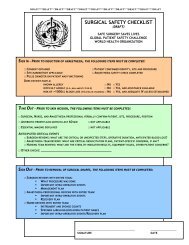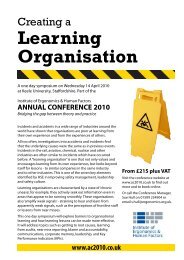The Essentials of Patient Safety - Clinical Human Factors Group
The Essentials of Patient Safety - Clinical Human Factors Group
The Essentials of Patient Safety - Clinical Human Factors Group
Create successful ePaper yourself
Turn your PDF publications into a flip-book with our unique Google optimized e-Paper software.
<strong>The</strong> <strong>Essentials</strong> <strong>of</strong> <strong>Patient</strong> <strong>Safety</strong><br />
Briefing and checklisting in surgery<br />
A number <strong>of</strong> studies have now been carried out which demonstrate the value <strong>of</strong><br />
checklisting and briefing which, although sometimes described separately, in practice<br />
usually occur together. <strong>The</strong> most influential study <strong>of</strong> surgical checklists has<br />
undoubtedly been that led by Atul Gawande as part <strong>of</strong> the World Health Organisation<br />
(13).<br />
<strong>The</strong> WHO surgical safety checklist ensures that the entire operating theatre<br />
team understands the patient, the surgical procedure the equipment needed and that<br />
evidence based interventions such as antibiotic prophylaxis or deep vein thrombosis<br />
prophylaxis are reliably given. <strong>The</strong> 19 item checklist is completed in three stages<br />
before induction <strong>of</strong> anaesthesia (sign in), just before skin incision (time out), and<br />
before the patient leaves the operating theatre (sign out). Items on the checklist must<br />
be verbally confirmed with the patient and other team members (14). <strong>The</strong> WHO Safe<br />
Surgery Saves Lives Study <strong>Group</strong> introduced the checklist in eight countries<br />
worldwide studying 3733 patients before and 3955 patients after the implementation<br />
<strong>of</strong> the checklist. After implementation, deaths were reduced from 1.5% to 0.8% and<br />
in-hospital complications by from 11% to 7.0%. In some sites the checklist prompted<br />
the introduction <strong>of</strong> techniques that are now standard in developed countries; for<br />
instance use <strong>of</strong> a pulse oximeter rose from 60% to over 90% in one study site over the<br />
course <strong>of</strong> the study.<br />
Briefings and checklists are however not a panacea. According to how they<br />
are used, can be either a positive or negative influence on team performance. A<br />
surgeon, for instance, can ostensibly take part in the briefing but express their<br />
superiority and detachment by not really listening and carrying out other tasks at the<br />
same time. A checklist can be read out by a nurse in a clipped and dismissive way<br />
which closes down all possibility <strong>of</strong> discussion within the team.<br />
<strong>The</strong>se two interventions are important examples <strong>of</strong> how teamwork and patient<br />
care can be improved with relatively simple measures, though persuading clinicians to<br />
use them and actually implement them may <strong>of</strong> course be monumentally difficult.<br />
Daily goals, pre-operative and post-operative checklists seem mundane, and this<br />
<br />
piece <strong>of</strong> paper or even a list; it is a team intervention which, used well, can affect the<br />
wider team functioning, the relationships across pr<strong>of</strong>essions and hierarchies and even<br />
the values and safety culture <strong>of</strong> the team.<br />
<strong>The</strong>se interventions just touch on some aspects <strong>of</strong> teamwork and it is<br />
important not to think that safety just means using more checklists. <strong>The</strong> real impact <strong>of</strong><br />
these approaches is to bring a shared understanding, to specify team leadership in<br />
particular situations, to anticipate problems. <strong>The</strong>se wider endeavours require a more<br />
sophisticated understanding <strong>of</strong> teamwork than we have at the moment and need to be<br />
fostered in new types <strong>of</strong> training involving groups <strong>of</strong> healthcare pr<strong>of</strong>essionals in novel<br />
simulations and other environments.<br />
43








